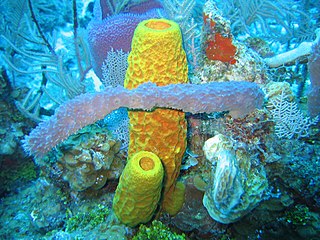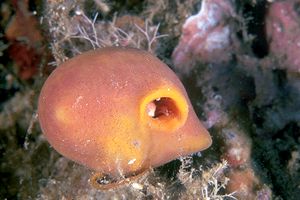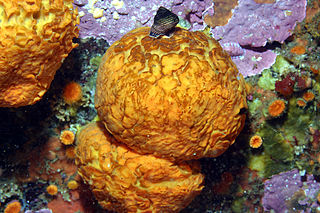
Demospongiae is the most diverse class in the phylum Porifera. They include 76.2% of all species of sponges with nearly 8,800 species worldwide. They are sponges with a soft body that covers a hard, often massive skeleton made of calcium carbonate, either aragonite or calcite. They are predominantly leuconoid in structure. Their "skeletons" are made of spicules consisting of fibers of the protein spongin, the mineral silica, or both. Where spicules of silica are present, they have a different shape from those in the otherwise similar glass sponges.

Suberites domuncula is a sponge belonging to the phylum Porifera.
Ecionemia is a genus of sea sponges belonging to the family Ancorinidae.
Placospongia is a genus of sea sponge belonging to the family Placospongiidae.
Ancorina is a genus of sea sponges belonging to the family Ancorinidae. It is the type genus of its family.

Geodia is a genus of sea sponge belonging to the family Geodiidae. It is the type genus of its taxonomic family.
Spirophorida is an order of sea sponges belonging to the class Demospongiae.

Hadromerida is an order of sea sponges belonging to the class Demospongiae.

Polymastia is a genus of sea sponges containing about 30 species. These are small to large encrusting or dome-shaped sponges with a smooth surface having many teat-shaped projections (papillae). In areas of strong wave action, this genus does not grow the teat structures, but instead grows in a corrugated form.

Halichondrida is an order of marine demosponges. Demosponges with simple spicules and a generally confused skeletal arrangement are grouped into this order although its monophyly is considered suspect and further taxonomic revision can be expected.

The hawksbill sea turtle is a Critically Endangered sea turtle belonging to the family Cheloniidae. It is the only extant species in the genus Eretmochelys. The species has a worldwide distribution, with Atlantic and Indo-Pacific subspecies—E. i. imbricata and E. i. bissa, respectively.
Spheciospongia vesparium, commonly known as the loggerhead sponge, is a species of demosponge belonging to the family Clionaidae. While it is highly toxic to many fish, this sponge is eaten by certain angelfish and is known to form part of the diet of the hawksbill sea turtle.

Bubarida is an order of demosponges in the subclass Heteroscleromorpha.

Clionaida is an order of demosponges in the subclass Heteroscleromorpha.
Scopalinidae is an family of demosponges in the subclass Heteroscleromorpha. It is the only family in the monotypic order Scopalinida.
Tethyida is an order of sea sponges in the subclass Heteroscleromorpha.

Agelasida is an order of sea sponges in the class Demospongiae.
Biemnida is an order of demosponges in the subclass Heteroscleromorpha.
Trachycladidae is a family of sea sponges in the subclass Heteroscleromorpha. It is the only family in the monotypic order Trachycladida.













